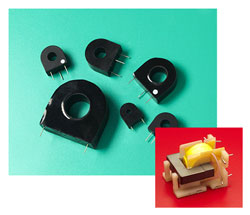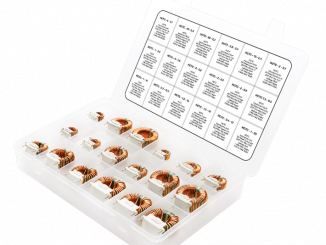By Frank Truetsch, Product Marketing Manager • Vacuumschmelze
In the past few years, innovative soft magnetic materials achieved a particular interest in electrical engineering and electronics and have led to various developments of special alloys. Vacuumschmelze GmbH & Co. KG (VAC) manufactures high grade soft magnetic materials and inductive component products for a wide variety of applications. The range of applications cover installation equipment, renewable energy and modern consumer products. They are often not visible from the outside, but fulfill important functions as for protection of equipment and persons, exact billing, low loss energy transmission or to provide interference-free operation of electronic devices. VAC is a manufacturer of modern magnetic alloys, cores and inductive components. The product range covers power and signal transformers, high precision current transformers, active and passive current sensors, inductors for power supplies and a wide range of EMC products.

Nanocrystalline cores are widely used in common mode choke (CMC) applications due to their unique combination of properties. They feature a high attenuation at low frequencies and improved EMC properties in the high frequency range.
The broadband attenuation and improved thermal properties achieve benefits in EMI filter design and an improved reliability compared to ferrite designs. In many cases, this characteristic can allow a reduction of the number of filter stages in multistage EMC filter configurations to reduce complexity, cost and filter volume. Ohmic (copper) losses are also reduced increasing the efficiency and lowering component temperature. Nanocrystalline CMC’s are more robust than ferrite products as they do not chip and crack and thus can be utilized in high shock and vibration environments. For automotive and aviation applications where component weight is a critical factor, nanocrystalline CMC’s can be used to decrease the overall system weight as they can achieve the same attenuation performance as ferrite components in much smaller package sizes.

By utilizing low-cost raw materials (Fe-based) and modern, large-scale production, Vitroperm is a suitable solution for a wide range of applications. Key areas of applications are switched-mode power supplies, uninterruptable power supplies, welding equipment, inverters for solar, wind and electric and hybrid vehicle systems, frequency converters and variable speed drives.
Nanocrystalline Vitroperm alloys are based on Fe with Si and B with Nb and Cu additives.
VAC pioneered the development of rapid solidification technology resulting in the production of thin tapes or ribbons approximately 20 ?m thick.
Special slitting and core winding machines produce tape-wound cores with outer diameters ranging from 2 mm to 600 mm. A subsequent heat treatment at around 500°C to 600°C transforms the initially amorphous microstructure of the tape into the desired nanocrystalline state. This being a two-phase structure with fine crystalline grains (average grain diameter of 10 nm to 40 nm) embedded in an amorphous residual phase. Vitroperm nanocrystalline alloys are optimized to combine highest permeability and lowest coercive field strength. The combination of very thin tapes and the relatively high electrical resistance (1.1 to 1.2 ??m) ensure minimal eddy current losses and an outstanding frequency vs. permeability behavior. Along with saturation flux density of 1.2 T and wide operational temperature range, these features combine to make VITROPERM a solution for most common EMC problems.
Vitroperm vs. Ferrite

The properties of Vitroperm are very different to conventional ferrites. This has to be considered in the filter design for optimal solutions. The permeability of Vitroperm 500F is significantly higher than ferrite in the low frequency range. At higher frequencies the ? of nanocrystalline materials remains above that of ferrites. The ?(f) of ferrites (µ about 5,000) offers a flat and linear characteristic from some 100 kHz up to approximately 1 MHz. In this flat range, the attenuation properties are determined by ?’’ and the impedance |Z| is dominated by the inductance L. If the self resonance of the choke is within this frequency range, the attenuation curve is narrow-band and attenuation is primarily caused by reflection of the interference signal. Above 1 MHz Re(Z) takes the major share of attenuation and ?’ becomes the dominant factor. If the self resonance of the choke is in this frequency range, the attenuation characteristic becomes increasingly broadband.
The flat sector of ?(f) of Vitroperm 500F ranges (depending on the initial permeability level) to frequencies of several 10 kHz (20 kHz in this example), only. Consequently, attenuation (or |Z|) is already dominated by Re(Z) and is always broadband in the whole EMC-relevant range above 150 kHz. Inductance plays a minor role and describes the attenuation only partially. The determining factor is the total impedance. The approximation |Z|=?L is valid for ferrite chokes. For Vitroperm chokes |Z|>>?L applies. Attenuation primarily does not result from a reflection of the interference signal, but from its absorption.
A high choke impedance is achieved more effectively by using high permeability core materials than by increasing the number of turns, as a lower number of turns results in lower winding capacitance and hence improved HF properties. At higher frequencies, the winding configuration of the choke has a major effect on the parameters of winding capacitance and leakage inductance.
VAC has extensive practical and theoretical expertise in the design of CMCs and EMC filter configuration using nanocrystalline cores and components to improve filter efficiency, maximize reliability and reduce costs. VAC encourages customers to utilize CMC design and manufacturing expertise to ensure that the optimum solution is applied.

Thermal Properties
The saturation flux density of VITROPERM changes by only a few percent in the operating temperature range of up to 150°C, while MnZn ferrites decline by up to 40 percent at temperatures above 100°C. The high Curie temperature of Vitroperm alloys (above 600°C), allows short term maximum operating temperatures as high as 180°C to 200°C.
Insertion loss (and impedance) of a CMC made of Vitroperm 500F is almost temperature-independent in the temperature range of –40°C to above 150°C. In contrast, ferrite chokes feature a drop of insertion loss with increasing temperature. This functional temperature independence is a critical feature in high temperature applications such as automotive and solar inverters.
Saturation Behavior
Very high inductance values in extremely compact core or choke dimensions increase the sensitivity to asymmetric magnetization conditions caused by common mode, unbalanced or leakage currents.
The saturation flux density of 1.2 T of Vitroperm is approximately three times higher than ferrites. However, a suitable µ level has to be selected very carefully in order to find the optimum saturation-resistant solution. High permeability Vitroperm 500F cores are characterized by an extremely high attenuation or impedance at low frequencies, and they are clearly improved against ferrites at high frequencies. However, the price of this improved performance is a more sensitive saturation behavior, which is improving with increasing frequency but still more critical than that of other core materials.
The material properties of nanocrystalline core materials allow common mode chokes with high inductance at a low number of turns. Vitroperm chokes are therefore well suited for high currents and high voltages. Further detailed information about nanocrystalline cores and common mode chokes of VAC is available in the recently published application note Nanocrystalline Vitroperm – EMC products.
References
[1] Petzold, J. “Applications of nanocrystalline softmagnetic cores in modern electronics”; Soft Magnetic Materials 16 (09.-12.09.2003), Vol. 1, page 97
[2] Klinger R.,“Nanocrystalline Vitroperm – EMC products”; Beichler, J. Vacuumschmelze GmbH & Co. KG, Application note 2010
[3] Petzold, J., “Nanocrystalline materials in common-mode chokes”; Klinger, R. PCIM Europe 6/2000
[4] Petzold, J., “Nanokristalline Kernwerkstoffe in stromkompensierten Klinger, R. Funkentstördrosseln”; EMC Kompendium 2001, page 148
[5] Beichler, J.“Designvorteile durch nanokristalline Kerne” E&E Kompendium 2005/2006, page 112
[6] Kvarnsjoe, L. “Green Inductive Components”; Power Systems Design Europe June 2009
 About the Author
About the Author
Frank Truetsch is an electrical engineer and acquired sales experience in variable speed drives, installation technology and for power and distribution transformers. Since beginning 2011 he has been the product marketing manager for Industrial Applications in Cores and Components business unit at Vacuumschmelze GmbH & Co. KG, Germany. Frank can be reached at frank.truetsch@vacuumschmelze.com.
Published in Summer 2011 Issue



